Original Title: "The Biggest Airdrop in Solana’s History - A Deep Dive on Jupiter"
Author: AYLO, alpha please
Translation: Elvin, ChainCatcher
Following the huge success of the Jito airdrop (peaking at a value of over $450 million), the next airdrop on the list is JUP, the token behind Jupiter, a significant DeFi aggregator on Solana.
The airdrop is scheduled for January 31st and is the most anticipated airdrop in Solana's history.
What sets Jupiter apart? Will JUP fulfill its promises? At what price should we sell? Or when should we consider increasing our holdings?
In this report, I will delve into all the information you need to know about the Jupiter product line, future plans, and the potential opportunities brought by the JUP airdrop.
Jupiter—One-Stop DeFi Service on Solana
Since its establishment in October 2021, Jupiter has been committed to creating the best decentralized trading experience on Solana. The platform aims to achieve this by aggregating various DeFi functionalities into one application and providing the most seamless user experience.
While Jupiter was initially envisioned as an exchange engine, the protocol has undergone significant developments, including many different products for various types of users, such as Dollar-Cost Averaging (DCA), limit orders, perpetual trading, and the recent launchpad.
In my opinion, the DCA tool may be the best product in DeFi at the moment.

Source: Jupiter Exchange
Jupiter's growth in 2023 has been remarkable, with monthly trading volume increasing by about tenfold—from $650 million in January to an impressive $7.1 billion in December. Notably, November saw a historic high in monthly trading volume after Breakpoint announced the JUP token, with the monthly trading volume exceeding $16 billion.
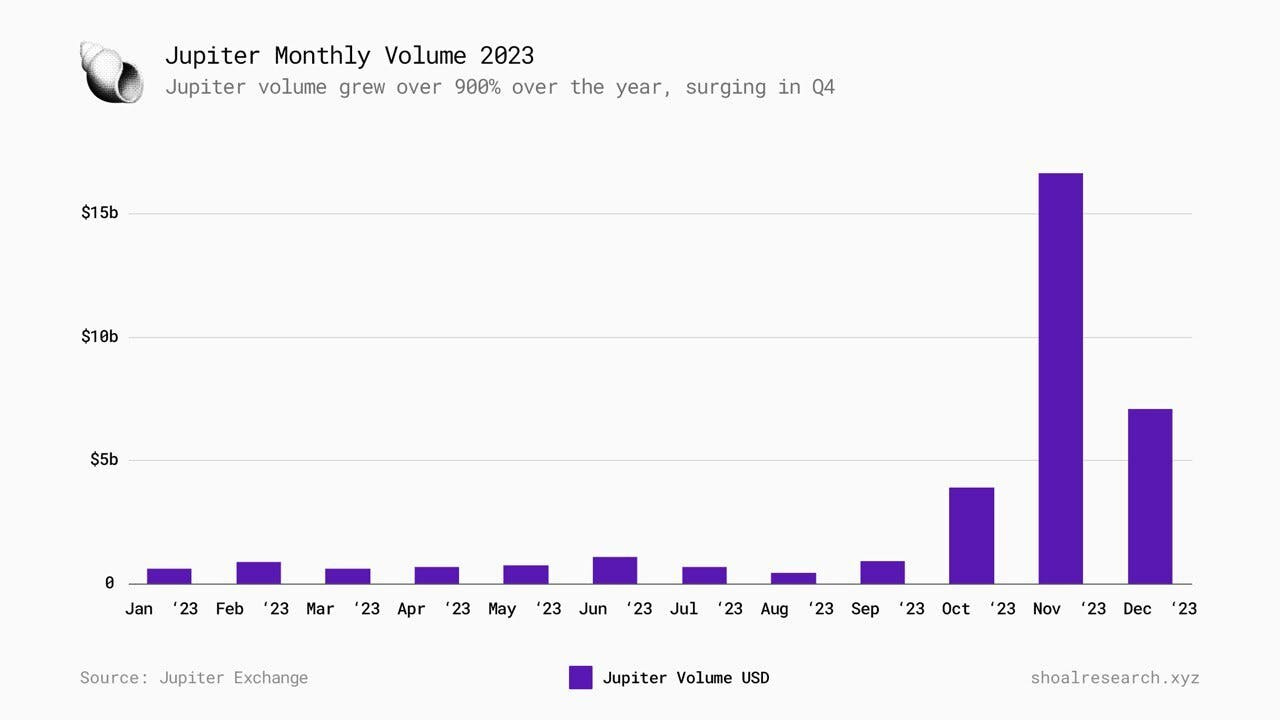
In the same context, Uniswap's monthly trading volume fluctuated from a low of $17.4 billion to over $70 billion in the same period.
To date, Jupiter has processed over $66.5 billion in trading volume and over 1.2 million transactions, becoming a key layer in the Solana ecosystem. It accounts for over 70% of all organic trading volume on Solana DEX and has become an important reference platform for Solana retail traders.
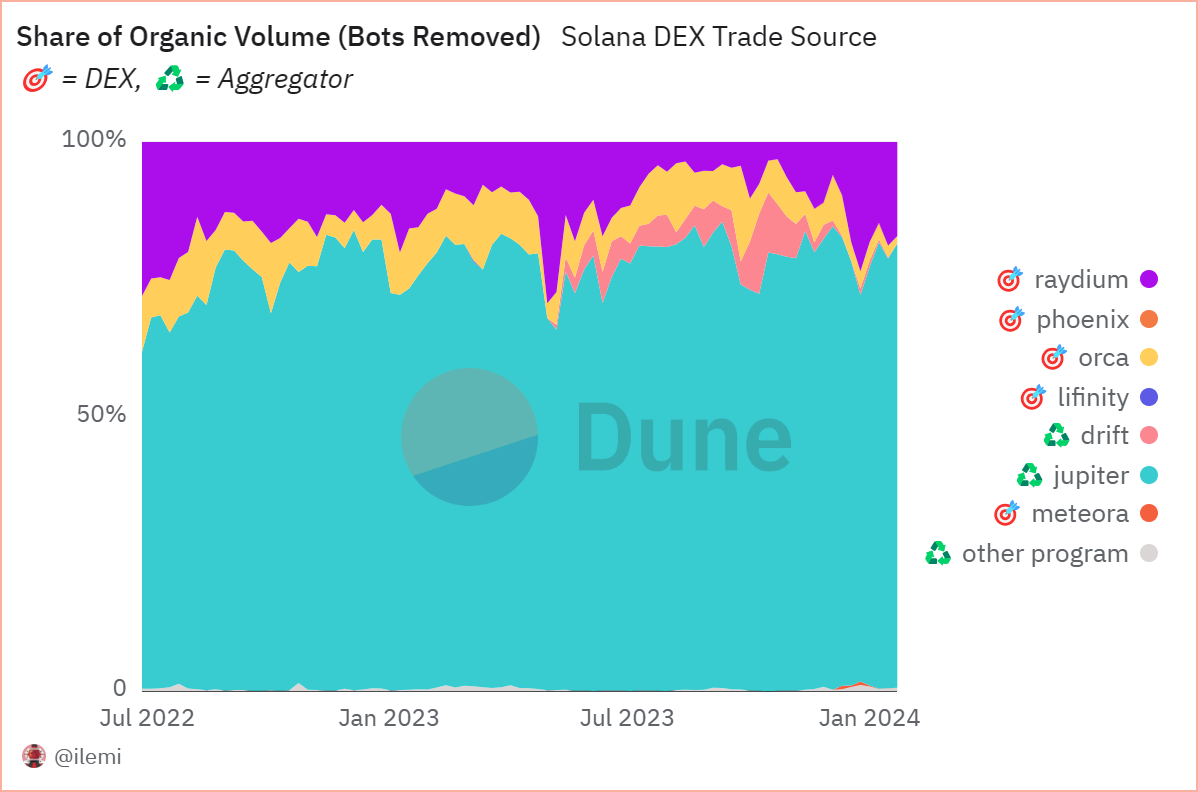
Source: Dune Analytics
Nevertheless, Jupiter remains committed to continuous innovation, aiming to improve existing functionalities and introduce new products consistent with its three main business model pillars:
- Providing the best user experience
- Maximizing the potential of Solana's technological capabilities
- Improving the overall liquidity of Solana
Given its unique position, I believe Jupiter is a bet on two things:
- 1. Long-term adoption of Solana: 2023 was a year of rebirth for Solana as network activity rebounded. I believe it has the potential to continue growing and capture a larger share of the L1 market. This could be favorable for Jupiter.
- 2. DeFi going mainstream: The future of trading is on-chain, and even CEOs of large traditional financial institutions like Larry Fink are beginning to talk about "tokenization of every financial asset." Therefore, it doesn't seem far-fetched to think that Jupiter can facilitate this shift.
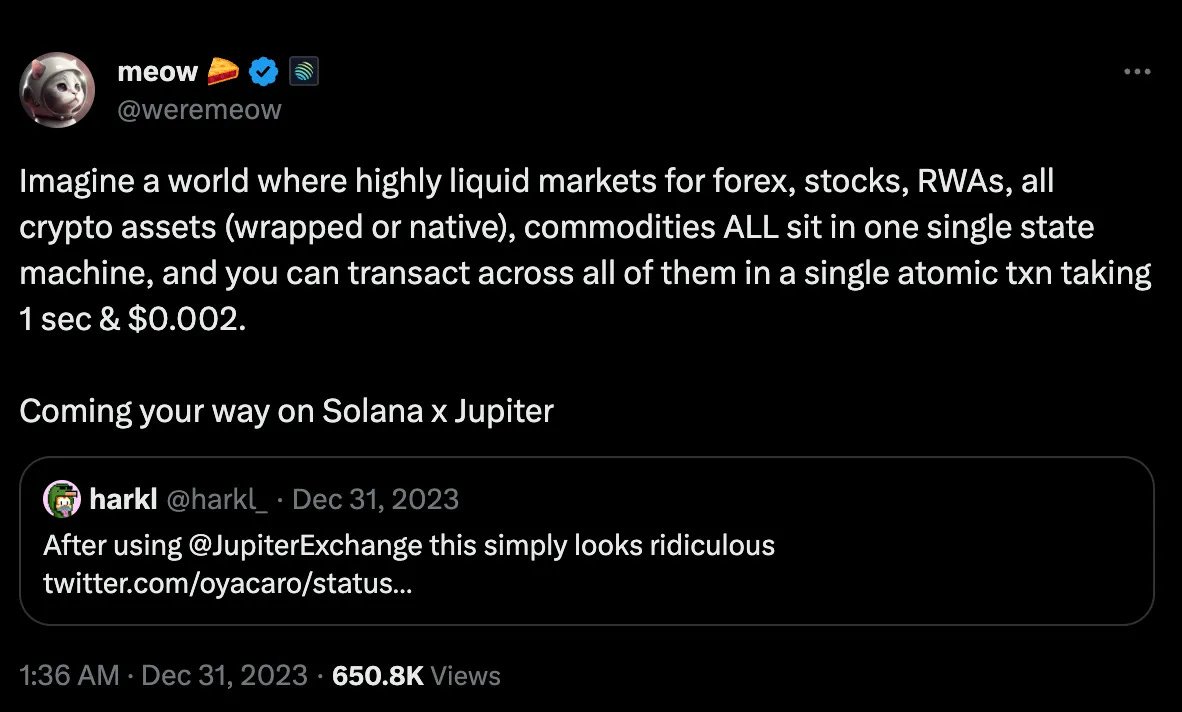
The recently announced JUP token further reflects Jupiter's strategic step in this direction.
JUP—Symbol of DeFi 2.0
The JUP token marks a significant milestone in the development and spirit of Jupiter. Just as Uniswap's governance token UNI symbolizes the first wave of DeFi on Ethereum, JUP aspires to embody the essence of DeFi 2.0 on Solana.
JUP is designed as a governance token, allowing holders to influence key aspects of the ecosystem. This includes voting on critical aspects of the token itself, such as the timing of initial liquidity provision, future emissions post-initial minting, and key ecosystem initiatives.
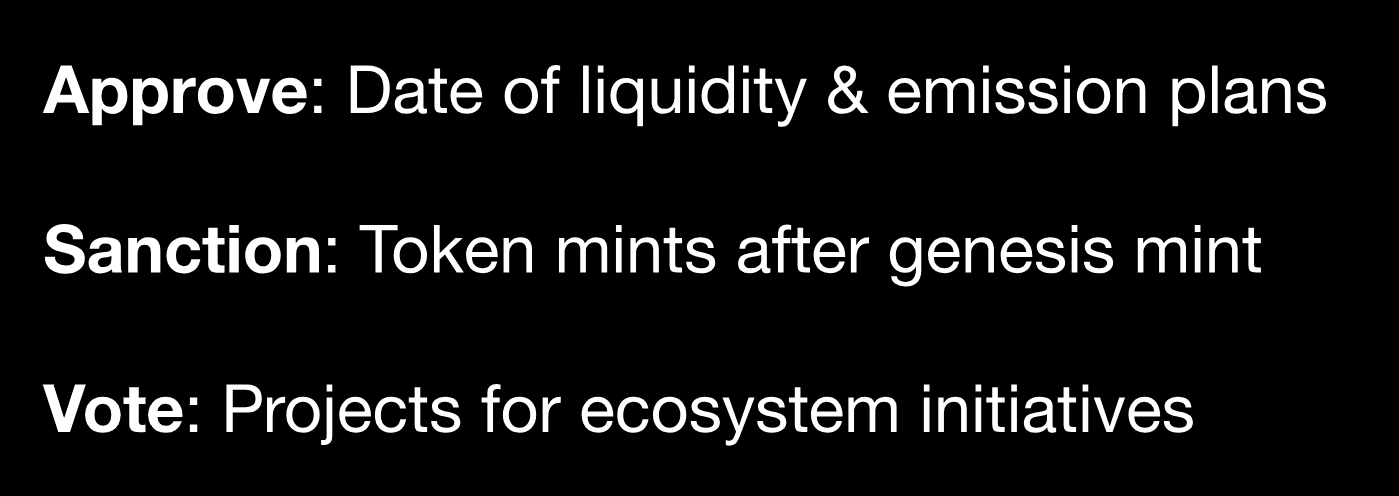
Source: Jupiter exchange
The primary goals of the token are:
- Injecting vitality into the Solana ecosystem by attracting new capital flows and users.
- Acting as a catalyst for introducing more ecosystem tokens: JUP is prepared to introduce more ecosystem tokens.
- Building a strong distributed JUP community.
As outlined by the anonymous co-founder Meow, JUP aspires to establish "the most effective, forward-looking, decentralized, non-internal voting DAO in DAO history."
Additionally, the utility of JUP will evolve over time, depending on the direction taken by the community. Potential future uses of the token may include:
- Reduced fees on perpetual exchanges.
- Improved access and allocation for launchpads.
- Fee sharing for Automated Market Makers (AMMs).
However, Meow has explicitly stated that they will not initiate revenue sharing until the user base grows at least tenfold.
Token Economics
The token economics reflect the spirit of the project, and Jupiter's vision is to keep it as simple as possible. The maximum supply is 10 billion JUP, with the tokens evenly distributed to 2 cold wallets—the team wallet and the community wallet. The team wallet will be used for current team allocations, finances, and liquidity provision, while the community wallet will be used for airdrops and various early contributors.
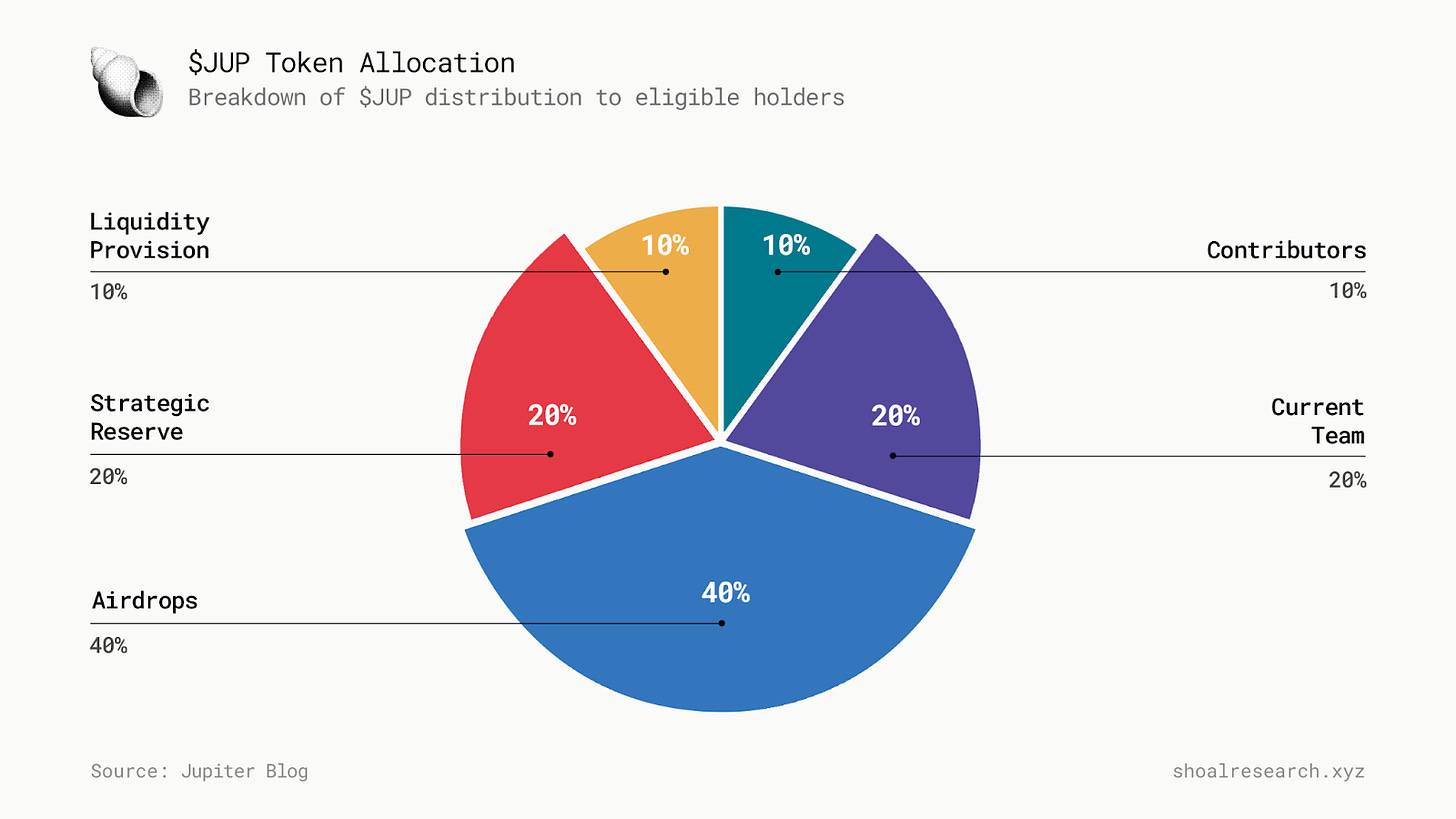
Airdrop Details
The first round of airdrops is scheduled for January 31st, with 10% of the total amount initially allocated to the community. The airdrop details are as follows:
1. Even distribution to all wallets (2%):
2 billion tokens will be evenly distributed to all users who have used Jupiter before November 2, 2023, equivalent to approximately 200 JUP per user.
2. Tiered distribution based on scores, with scores based on the unadjusted amount (7%):
The distribution is approximately as follows:
- Level 1: Top 2,000 users, 100,000 tokens per user (expected >1M trading volume)
- Level 2: Next 10,000 users, 20,000 tokens per user (expected >100K trading volume)
- Level 3: Next 50,000 users, 3,000 tokens per user (expected >10K trading volume)
- Level 4: Next 150,000 users, 1,000 tokens per user (expected >1K trading volume)
3. Community members on Discord, Twitter, and developers (1%):
1 billion tokens will be allocated to the most valuable contributors and community members.
There will be three more rounds of airdrops in the future.
JUP Token Valuation—Comparison with JTO
A common question that arises with a new airdrop is determining the fair value of the token.
While JUP does not have a direct way to answer this question, one approach could be to compare and analyze the recent airdrop project JTO token on Solana.
JTO is the governance token of Jito lab, a Solana-based liquidity staking platform. The airdrop distributed 10% of the JTO supply to approximately 10,000 users. The peak value of the airdrop exceeded $450 million.
JTO Price Analysis
Using the initial reference price of $2.13 on Binance (after the initial market fluctuations), here is a summary of the price trend after the listing of JTO:

Source: Binance
From this table, we can observe some trends:
Initially, on the first day of trading, the token price experienced significant fluctuations from $1.74 to $3.77. Additionally, the price was above the initial reference price of $2.13 for 83% of the time.
Furthermore, it is noteworthy that the first week of trading was indeed positive for JTO. The token's trading price was above its reference price for over 97% of the time and reached a historical high point (ATH) of $4.45.
Looking at the percentage of time spent in different price ranges, we find that JTO did not spend a significant amount of time at its ATH level, as only 0.18% of the time was spent at more than double the reference price of $2.13.
Additionally, we also see that JTO did not experience a retracement of over 50% relative to the initial price. Furthermore, it was in a state of over 25% retracement for only about 8.6% of the time.
While the price trend of JUP may not necessarily mirror the path of JTO, some assumptions can be made:
- The first trading day of JUP is expected to experience significant volatility, potentially providing opportunities for short-term traders.
- The launch of JUP may generate significant excitement and could reach local peaks in the first week of trading. Rapid increases, exceeding double the initial price, may signal selling opportunities.
- Conversely, if the price drops by over 50% from the initial price, it may be considered a buying opportunity.
"Overbought" Indicator—JTO FDV/LDO FDV Ratio
Jito is similar to the Lido protocol. Their main difference is that Jito is on Solana, while Lido is on Ethereum. Therefore, a reasonable method of token pricing when JTO is launched involves examining the relationship between JTO's fully diluted valuation (FDV) and LDO (Lido's governance token) FDV. Through this comparison, we can understand the market's valuation of JTO relative to a similar product on Ethereum.
Here is the JTO FDV/LDO FDV ratio over time since the establishment of JTO:
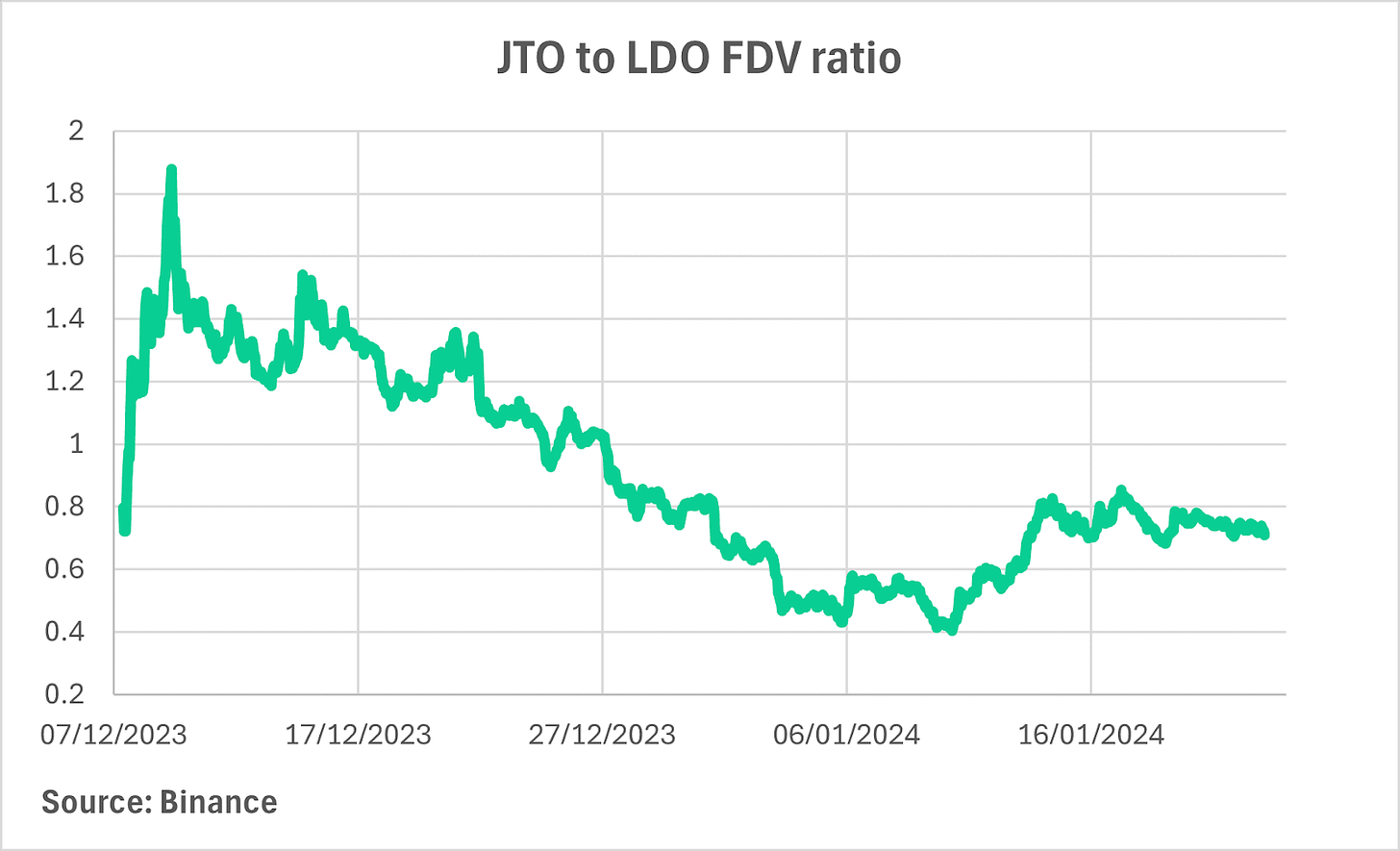
We observe that after the listing of JTO, the trading price quickly exceeded the LDO FDV, reaching a ratio close to 1.9, which is double the LDO FDV. However, this surge may reflect the peak of market excitement, and the market quickly repriced JTO to lower levels. In the following weeks, the JTO/LDO FDV ratio trended downward, reaching the 0.4 threshold, followed by a strong rebound to the 0.7-0.8 level. So far, the market seems to have settled on a fair value within this range, which aligns well with the average of 0.9 over the past few months.
We can conclude that a ratio exceeding 1.6 represents a clear overbought signal for JTO, while 0.4 represents a strong oversold signal.
Applying this Valuation to JUP
Just as LDO serves as the relative equivalent to JTO, we need to find an anchor for comparison for JUP on Ethereum.
Given that Jupiter operates as the largest decentralized exchange (DEX) on Solana, with features such as Automated Market Makers (AMMs), DCA, perpetual trading, and Launchpad opportunities, finding a single project on Ethereum with a comparable range is challenging. Therefore, I believe a combination of Uniswap, dydX, and DAO Maker can be interpreted as the closest peers to JUP. Hence, their combined FDV totals approximately $10.04 billion at the time of writing.
We can use the FDV data of this combination and the key levels of the JTO/LDO FDV ratio to estimate the different scenarios for JUP's price.

Source: Binance
By adopting the same relative valuation analysis, we can obtain these key price levels to improve airdrop decisions:

However, it is worth noting that JTO has a relatively high daily Beta value of 0.86. Therefore, the price movement of JTO is closely related to the price movement of Solana, and JUP is likely to follow the same pattern. Thus, the current market conditions can significantly impact the hype generated by this airdrop.
At the time of writing, the trading price of Solana is $80-82, lower than the $120-130 level. This indicates a drop of over 30%, suggesting that the market conditions may not be as optimistic as during the JTO airdrop.

A comparison of the JTO airdrop one month before with the recent SOL price clearly shows a change in market conditions. Therefore, it seems reasonable to assume that this may have a negative impact on the price of JUP.
Potential Airdrop Rewards
Can this airdrop be as big as the JTO airdrop? Let's analyze it together.
If we refer to the different rewards given at each level, we can determine the potential airdrop potential of JUP at a given price:

Source: Jupiter Exchange
In contrast, here are the JTO rewards at different levels and different key prices:

Source: Jito Labs
Even at the historical low price of $1.323, the scale of JTO airdrops at each level exceeds the potential rewards of JUP airdrops, even at $2,000 per user for JUP's valuation (20,000 tokens per user at $2).
For example, in order for the lowest level of JUP to match the reward at the lowest level of JTO at the historical low price, the trading price of JUP would need to exceed $20. This implies an FDV of $200 billion, a figure that is completely unrealistic.
However, it must be emphasized that the JTO airdrop was concentrated among 10,000 users, while JUP will distribute its tokens to nearly 1 million users. This also means that there are many buyers on the sidelines for JTO, hoping to gain exposure, while JUP's distribution is much broader, so initial buyers may be fewer.
The market also did not anticipate that JTO would eventually reach such a large market value, and there seems to be very high expectations for JUP, so this is also a key difference to consider. When everyone expects the same thing, the results are rarely like this.
Therefore, while the JUP airdrop may not provide individual users with as lucrative rewards as the JTO airdrop, its broader impact on a larger user base makes it one of the most crucial, if not the most crucial, airdrops on Solana to date.
We are likely to see a significant increase in on-chain activity after the JUP airdrop. For many, this will act as a relief check, and for degens, their style will be more aggressive, often chasing higher returns with what they perceive as "free money" from JUP.
Finally, as people cash out their JUP profits into SOL, SOL may also benefit from increased buying pressure, but it is clear that the market's bullishness in the short term is much lower, making it difficult to gauge how SOL will perform in lower time frames.
免责声明:本文章仅代表作者个人观点,不代表本平台的立场和观点。本文章仅供信息分享,不构成对任何人的任何投资建议。用户与作者之间的任何争议,与本平台无关。如网页中刊载的文章或图片涉及侵权,请提供相关的权利证明和身份证明发送邮件到support@aicoin.com,本平台相关工作人员将会进行核查。




